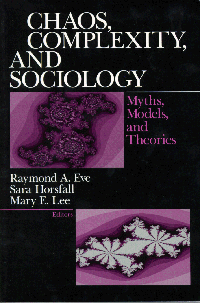Reviewed by
Alan Dean
School of Comparative and Applied Social Sciences, The University of Hull, Hull, HU6 7RX.

Chaos theory has now been around for some time and there can be few people in any field of academic life who are not at least slightly familar with its central focus on unpredictability and sensitive dependence upon initial conditions. We all know that chaos theory tells us something about the weather, even if it is only that a butterfly flapping its wings in Brazil could theoretically create a storm in, say, France. Over time interest in these ideas has increased among social scientists and in consequence now and then articles appear in academic journals that seek to apply chaos theory to a wide range of fields such as alcohol use, warfare, economic cyles or social interaction. These are important new developments, but their focus has generally been rather specialised. Nevertheless, this growing body of work has moved chaos theory closer to centre stage in the social sciences and sociology is no exception. Interest in the exploration and articulation of unpredictability, contingency and discontinuous change has been at the centre of sociology through developments in postmodern social theory. It is therefore not surprising that researchers are engaging with ideas from chaos theory given the convergence of interest in providing critiques of modern social theory.
These circumstances have produced a demand for introductory texts aimed bot only at researchers seeking to enter the field, but also at postgraduate and undergraduate students. It is towards this audience that the book edited by Eve, Horsfall and Lee appears to be directed. However, the success of the book is this regard is only partial. There are chapters that are well suited to the likely audience. Price's chapter on the myth of postmodern science was particularly welcome because any attempt to apply chaos and complexity within sociology must engage with postmodern social theory. It is essential that the application of chaos and complexity research is undertaken by way of a dialogue with existing social theory. This means showing where chaos leads on from, or adds to, what has already been said within the postmodern movement, especially in terms of post-structuralism. But it also means that the critique of modern social science implicit within chaos theory needs to be made explicit. Price's chapter provides a starting point in this regard, even though in the final analysis it is somewhat incomplete and too biased towards Foucault. Nevertheless it is worth reading if only to get the reader started on their own lines of reasoning.
For similar reasons the chapter by Lee on the contribution chaos theory could make to a non-modern social theory is also enjoyable and very useful. Lee is correct to deduce that from a social theoretical standpoint, chaos theory leads to a non-modern perspective, as outlined by Bruno Latour (1993).
Mihata's chapter on emergence is also a key contribution to the volume. From a theoretical position, the concept of emergence has to be a central pillar in any development of chaos theory applications within sociology. Understanding the nature of emergence enables students to grasp new ways of thinking about probability and avoid resorting to reductionism. Mihata's chapter presents the concept of emergence in a clear and easily understood manner. With similar teaching objectives in mind, I would also recommend Smith's chapter on the relationship between microscopic and macroscopic social phenomena.
With regard to the rest of the book, recalling that it appears to be intended as a text designed for students and others seeking a way in to this new approach in the social sciences, I am not convinced that the overall choice of papers best serves its natural readership. Some papers are somewhat outside the mainstream of sociological issues, for example the chapter by Bainbridge on the Omicron Point. Others are too brief to be really helpful. The chapters on method tend to fall into this latter category.
Part three on conceptual models and applications is structured in what seems to be a rather arbitrary manner. Perhaps the contributions were selected on a pragmatic basis? As examples of what leading scholars (such as Kathleen Carley) are doing in the field, these chapters work well. However, I am not sure that the majority of readers likely to either buy or borrow this book would want to spend too much time grappling with the complexity of very specialised areas of empirical research. There is quality there, but substantively is it what the average reader would want?
In summary, a useful book for students and those new to the area who are seeking a general text structured at least in part for a sociological audience. Particular chapters are very helpful, but much of it would, I feel from my judgement of its audience, be left unread. What is really needed in this field is a treatment that engages with existing debates in sociology and anthropology on a theoretical level, rather than one that, with some exceptions, is structured in an exclusive manner. Perhaps understandably at the present time most social scientist working with chaos theory are interested in empirical, computer-based studies and not those from a social theoretical background. (Certainly the typical contributions to the simsoc mailing list suggest this.) One central challenge in this field is to develop new theoretical critiques of existing social science. This book makes a start. In that respect at least, it is worth reading although in a selective manner.
LATOUR B. 1993. We Have Never Been Modern, Harvester Wheatsheaf, Hemel Hempstead.
Return to Contents
of this issue
© Copyright Journal of Artificial Societies and Social Simulation, 1999